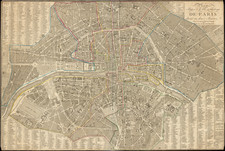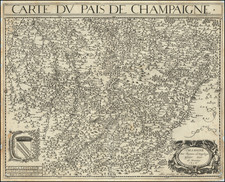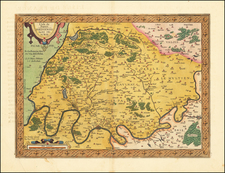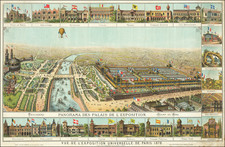Paris After the Haussman Renovations -- Expanding Metropolitan Paris
Fine and elegantly colored map of the Greater Paris metropolitan area, based in large part on Xavier Girard's important postal map of Paris, published in 1857, but covering a wider area, reflecting the growth of the City between the 1850s and 1880s.
The map shows the remarkable growth of the city, literally in all directions. Most notable are the changes and expansions which occurred around the time of the 1878 World's Fair, including the construction of the Palais du Trocadéro (1878–1936) and the expanded coverage to include the Bois de Boulogne and Hippodrome de Longchamp.
The Parc des Buttes Chaumont is shown. Opened in 1867, the park was created during the late in the regime of Napoleon III, built according to plans by Jean-Charles Adolphe Alphand, who created all the major parks demanded by the Emperor.
The area along the Seine River between the Gare d'Orleans and Gare de Lyon, formerly the Entrepot de Bercy, have now been significantly redeveloped. During the 19th century, the Bercy docks became one of the most significant wine markets in the world. The area was filled with vast wine cellars, storage houses, and trading offices, efficiently connected by rail and water. For nearly a century, Bercy was the heart of wine trading in Paris. Vintners from across France sent their barrels to these warehouses, where the wine would be stored, aged if necessary, and then dispatched to different parts of the city or even exported.
Haussmann's renovation of Paris was a vast public works program commissioned by Emperor Napoléon III, and directed by the Prefect of the Seine, Georges-Eugène Haussmann, between 1853 and 1870. It included the demolition of crowded and unhealthy medieval neighborhoods, the building of wide avenues, parks and squares, the annexation of the suburbs surrounding Paris, and the construction of new sewers, fountains and aqueducts. Haussmann's work met with fierce opposition, and he was finally dismissed by Napoleon III in 1870; but work on his projects continued until 1927. The street plan and distinctive appearance of the center of Paris today is largely the result of Haussmann's renovation.















![[Paris] Lutetia vulgari Nomine Paris, Urbs Galliae Maxima . . .](https://storage.googleapis.com/raremaps/img/small/96922.jpg)
